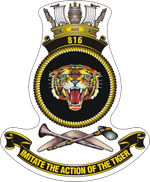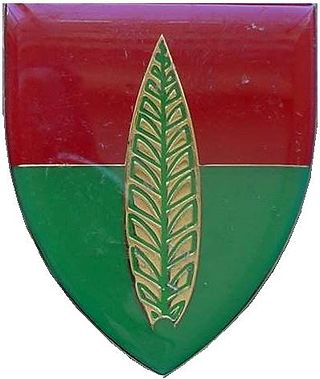SON-50 (NATO reporting name Flap Wheel) is a type of Russian\Soviet fire director radar for 57 mm anti-aircraft guns.
It was widely employed during the Vietnam War.

An anti-aircraft vehicle, also known as a self-propelled anti-aircraft gun (SPAAG) or self-propelled air defense system (SPAD), is a mobile vehicle with a dedicated anti-aircraft capability.

INSVikrant was a Majestic-class aircraft carrier of the Indian Navy. The ship was laid down as HMS Hercules for the British Royal Navy during World War II, but was put on hold when the war ended. India purchased the incomplete carrier in 1957, and construction was completed in 1961. Vikrant was commissioned as the first aircraft carrier of the Indian Navy and played a key role in enforcing the naval blockade of East Pakistan during the Indo-Pakistani War of 1971.

A missile is an airborne ranged weapon capable of self-propelled flight aided usually by a propellant, jet engine or rocket motor.

Anti-aircraft warfare is the counter to aerial warfare and it includes "all measures designed to nullify or reduce the effectiveness of hostile air action". It includes surface based, subsurface, and air-based weapon systems, associated sensor systems, command and control arrangements, and passive measures. It may be used to protect naval, ground, and air forces in any location. However, for most countries, the main effort has tended to be homeland defence. Missile defence is an extension of air defence, as are initiatives to adapt air defence to the task of intercepting any projectile in flight.
United Nations General Assembly Resolution 1761 was passed on 6 November 1962 in response to the racist policies of apartheid established by the South African Government.

The Flak 30 and improved Flak 38 were 20 mm anti-aircraft guns used by various German forces throughout World War II. It was not only the primary German light anti-aircraft gun but by far the most numerously produced German artillery piece throughout the war. It was produced in a variety of models, notably the Flakvierling 38 which combined four Flak 38 autocannons onto a single carriage.

816 Squadron is a Royal Australian Navy Fleet Air Arm squadron that started out as a Royal Navy unit, 816 Naval Air Squadron.

Georg Gustaf Wilhelm von Braun was a Swedish horse rider who competed in the 1920 and 1924 Summer Olympics. In 1920 he and his horse Diana finished eighth in the individual eventing competition and won a gold medal with the Swedish eventing team. Four years later he finished 19th in the individual jumping and was a member of the gold medal-winning Swedish team. He did not receive any medal for that at the time, but is listed as a gold medalist for that too on IOC's site.

The KS-19 100mm anti-aircraft gun is a Soviet anti-aircraft gun that also features good capabilities against ground targets.

The Fargo-class cruisers were a modified version of the Cleveland-class cruiser design; the main difference was a more compact pyramidal superstructure with single trunked funnel, intended to improve the arcs of fire of the anti-aircraft (AA) guns. The same type of modification differentiated the Baltimore and Oregon City classes of heavy cruisers, and to a lesser degree the Atlanta and Juneau classes of light cruisers. Changes were made in order to reduce the instability of the Cleveland-class light cruisers, especially their tendency to roll dangerously. The main battery turrets sat about a foot lower and the wing gunhouses were lowered to the main deck. The medium (40 mm) anti-aircraft mounts were also lowered.

The Bombing of Tan Son Nhut Air Base occurred on April 28, 1975, just two days before the Fall of Saigon. The bombing operation was carried out by the Vietnam People's Air Force (VPAF) Quyet Thang Squadron, using captured Republic of Vietnam Air Force (RVNAF) A-37 Dragonfly aircraft flown by VPAF pilots and RVNAF defectors led by Nguyen Thanh Trung who had bombed the Presidential Palace in Saigon on 8 April 1975.

7 Light Anti-Aircraft Regiment is a reserve force regiment of the South African Army Air Defence Artillery Formation.

10 Anti-Aircraft Regiment is an anti-aircraft artillery regiment of the South African Army.

Galeshewe Anti-Aircraft Regiment is a reserve air defence artillery regiment of the South African Army.

Air Defence Artillery School is an artillery unit of the South African Army. It is located on the southern side of Kimberley near the airport in an area known as Diskobolos clustered with other military units.

Regiment University of Cape Town was an artillery regiment of the South African Army. As a reserve unit, it had a status roughly equivalent to that of a British Army Reserve or United States Army National Guard unit. It was part of the South African Army Artillery Corps.
The 5th Anti-Aircraft Missile Division of the Air Force was activated on July 1, 1979, in Langfang, Beijing. The division was composed of the 16th, 26th and 27th Anti-aircraft Missile Regiments, being responsible for the anti-air defense of the southern vicinity of Beijing.
The DFS Model 6 was a target glider built by Deutsche Forschungsanstalt für Segelflug in 1936. It was intended for anti-aircraft training, but only prototypes were built. It was assigned the RLM designation 8-6.
The Reserve Antiaircraft Artillery Division of Hubei Provincial Military District moved to Wuhan, Hubei and was reconstituted by Reserve Division of Xiangyang which was activated on September 13, 1983, in Xiangyang, Hubei.
The Air Defense Department of Fujian Military District was activated in July 1950. According to the order issued by the General Staff Department on March 10, 1955, the 105th Anti-Aircraft Artillery Division of Air Defense Force was activated in Fuzhou, Fujian province on April 30, 1955.